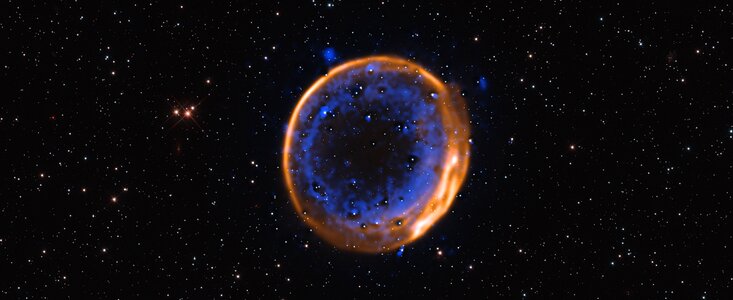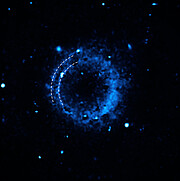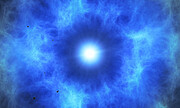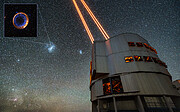Persbericht
Dubbelknaller: nieuwe opname toont overblijfselen van ster die tweemaal explodeerde
2 juli 2025

Voor het eerst hebben astronomen visueel bewijs gevonden dat een ster aan zijn einde is gekomen door twee keer te ontploffen. Door met de Very Large Telescope (VLT) van de Europese Zuidelijke Sterrenwacht (ESO) de eeuwenoude overblijfselen van supernova SNR 0509-67.5 te onderzoeken, hebben ze patronen gevonden die bevestigen dat de ster twee explosies heeft ondergaan. De ontdekking, die vandaag wordt gepubliceerd, plaatst enkele van de belangrijkste explosies in het heelal in een nieuw licht.
De meeste supernova’s zijn het gevolg van zware sterren die aan het einde van hun bestaan exploderen, maar één variant kent een bescheidener bron. Witte dwergen – de kleine, inactieve kernen die overblijven nadat sterren zoals onze zon hun nucleaire brandstof hebben verbruikt – kunnen een supernova van type Ia produceren.
‘De explosies van witte dwergen spelen een cruciale rol in de sterrenkunde’, zegt Priyam Das, promovendus aan de Universiteit van New South Wales in Canberra (Australië), die leiding gaf aan het onderzoek naar SNR 0509-67.5, waarvan de resultaten vandaag in Nature Astronomy zijn gepubliceerd. Veel van onze kennis over hoe het heelal uitdijt, is gebaseerd op supernova’s van type Ia, die tevens een belangrijke bron van het ijzer op onze planeet zijn, inclusief het ijzer in ons bloed.
‘Ondanks het belang van deze supernova’s blijft het aloude vraagstuk van het exacte mechanisme dat hun explosie in gang zet onopgelost’, voegt Das daaraan toe.
Alle modellen die supernova’s van type Ia verklaren, gaan uit van een dubbelster, bestaande uit een witte dwerg en een andere ster die om elkaar heen draaien. Als de afstand tussen beide sterren klein genoeg is, kan de dwerg materiaal van zijn partner ‘stelen’. Volgens de meest gangbare theorie achter deze explosies verzamelt de witte dwerg materie van zijn partner totdat hij een kritische massa bereikt en een enkelvoudige explosie ondergaat. Recente onderzoeken doen echter vermoeden dat in elk geval sommige supernova’s van type Ia beter verklaard kunnen worden door een dubbele explosie die plaatsvindt vóórdat de ster zijn kritische massa heeft bereikt.
Astronomen hebben nu een nieuwe opname gemaakt die dit vermoeden bevestigt: ten minste sommige supernova’s van type Ia exploderen niet één, maar twee keer. Volgens dit alternatieve scenario vormt zich een deken van gestolen helium om de witte dwerg heen, die instabiel wordt en vervolgens kan ontbranden. Deze eerste explosie veroorzaakt een schokgolf in de kern van de witte dwerg, die de uiteindelijke supernova teweegbrengt.
Tot nu toe bestond er geen duidelijk visueel bewijs voor een witte dwerg die een dubbele ontploffing onderging. Maar recent hebben astronomen voorspeld dat dit proces een karakteristiek patroon – een soort vingerafdruk – zal achterlaten in de nog nagloeiende overblijfselen van de supernova, die nog lang na de eerste explosie zichtbaar zouden zijn. Onderzoek wijst erop dat de overblijfselen van zo’n supernova twee afzonderlijke schillen van calcium zouden bevatten.
Astronomen hebben deze specifieke vingerafdruk nu aangetroffen in de overblijfselen van een supernova. Ivo Seitenzahl, die leiding gaf aan de waarnemingen en tijdens het onderzoek verbonden was aan het Heidelberger Institut für Theoretische Studien in Duitsland, zegt dat deze resultaten een duidelijke aanwijzing zijn dat witte dwergen kunnen exploderen lang voordat ze de beroemde Chandrasekhar-limiet bereiken, en dat het ‘dubbele-detonatie’-mechanisme inderdaad voorkomt in de natuur’. Het team is erin geslaagd om de voorspelde calciumschillen (de blauwe kringen op de foto) te detecteren in de supernovarest SNR 0509-67.5 met behulp van de Multi Unit Spectroscopic Explorer (MUSE) van ESO’s VLT. Dit heeft het onomstotelijke bewijs opgeleverd dat een supernova van type Ia kan ontstaan vóórdat een witte dwerg zijn kritieke massa bereikt.
Supernova’s van type Ia zijn essentieel voor ons begrip van het heelal. Ze gedragen zich heel consistent en hun voorspelbare helderheid – ongeacht hoe ver ze van ons verwijderd zijn – helpt astronomen om afstanden in het heelal te meten. Door ze als kosmische meetlatten te gebruiken, hebben astronomen de versnellende uitdijing van het heelal ontdekt – een ontdekking die in 2011 werd bekroond met de Nobelprijs voor Natuurkunde. Door te onderzoeken hoe ze ontploffen, helpt ons begrijpen waarom ze zo’n voorspelbare helderheid hebben.
Das heeft nog een andere reden om deze explosies te onderzoeken: ‘Dit tastbare bewijs voor een dubbele explosie draagt niet alleen bij aan het oplossen van een al lang bestaand vraagstuk, maar is tevens een prachtig visueel spektakel’, zegt hij, verwijzend naar de prachtige gelaagde structuur die een supernova achterlaat. Voor hem ‘is het onthullen van de innerlijke werking van zo’n spectaculaire kosmische explosie ongelooflijk bevredigend.’
Meer informatie
De resultaten van dit onderzoek zijn te vinden in het artikel ‘Calcium in a supernova remnant shows the fingerprint of a sub-Chandrasekhar mass explosion’, dat in Nature Astronomy verschijnt.
Het onderzoeksteam bestaat uit: P. Das (University of New South Wales, Australië [UNSW] & Heidelberger Institut für Theoretische Studien, Heidelberg, Duitsland [HITS]), I.R. Seitenzahl (HITS), A.J. Ruiter (UNSW & HITS & OzGrav: The ARC Centre of Excellence for Gravitational Wave Discovery, Hawthorn, Australië & ARC Centre of Excellence for All-Sky Astrophysics in 3 Dimensions), F.K. Röpke (HITS & Institut für Theoretische Astrophysik, Heidelberg, Duitsland & Astronomisches Recheninstitut, Heidelberg, Duitsland), R. Pakmor (Max-Planck-Institut für Astrophysik, Garching, Duitsland [MPA]), F.P.A. Vogt (Federal Office of Meteorology and Climatology – MeteoSwiss, Payerne, Zwitserland), C.E. Collins (The University of Dublin, Dublin, Ierland & GSI Helmholtzzentrum für Schwerionenforschung, Darmstadt, Duitsland), P. Ghavamian (Towson University, Towson, VS), S.A. Sim (Queen’s University Belfast, Belfast, VK), B.J. Williams (X-ray Astrophysics Laboratory NASA/GSFC, Greenbelt, VS), S. Taubenberger (MPA & Technische Universität München, Garching, Duitsland), J.M. Laming (Naval Research Laboratory, Washington, VS), J. Suherli (University of Manitoba, Winnipeg, Canada), R. Sutherland (Australian National University, Weston Creek, Australië), en N. Rodríguez-Segovia (UNSW).
De Europese Zuidelijke Sterrenwacht (ESO) stelt wetenschappers van over de hele wereld in staat om de geheimen van het heelal te ontdekken, ten bate van iedereen. Wij ontwerpen, bouwen en exploiteren observatoria van wereldklasse die door astronomen worden gebruikt om spannende vragen te beantwoorden en de fascinatie voor astronomie te verspreiden, en bevorderen internationale samenwerking op het gebied van de astronomie. ESO, in 1962 opgericht als intergouvernementele organisatie, wordt inmiddels gedragen door 16 lidstaten (België, Denemarken, Duitsland, Finland, Frankrijk, Ierland, Italië, Nederland, Oostenrijk, Polen, Portugal, Spanje, Tsjechië, het Verenigd Koninkrijk, Zweden en Zwitserland) en door het gastland Chili, met Australië als strategische partner. Het hoofdkwartier van de ESO en haar bezoekerscentrum en planetarium, de ESO Supernova, zijn gevestigd nabij München in Duitsland, maar onze telescopen staan opgesteld in de Chileense Atacama-woestijn – een prachtige plek met unieke omstandigheden voor het doen van hemelwaarnemingen. ESO exploiteert drie waarnemingslocaties: La Silla, Paranal en Chajnantor. Op Paranal staan ESO’s Very Large Telescope en Very Large Telescope Interferometer, evenals surveytelescopen zoals VISTA. Ook zal ESO op Paranal de Cherenkov Telescope Array South huisvesten en exploiteren – ’s werelds grootste en gevoeligste observatorium van gammastraling. Samen met internationale partners beheert ESO APEX en ALMA op Chajnantor, twee faciliteiten die de hemel waarnemen in het millimeter- en submillimetergebied. Op Cerro Armazones, nabij Paranal, bouwen wij ‘het grootste oog ter wereld’ – ESO’s Extremely Large Telescope. Vanuit onze kantoren in Santiago, Chili, ondersteunen wij onze activiteiten in het gastland en werken wij samen met Chileense partners en de Chileense samenleving.
Links
- Onderzoeksartikel
- Foto’s van de VLT
- Voor journalisten: abonneer je op persberichten onder embargo in je eigen taal
- Voor wetenschappers: heb je een verhaal? Communicatie-afdeling ESO
- Nieuwe ESO-analyse bevestigt: ernstige schade door gepland industrieel complex bij Paranal
Contact
Priyam Das
School of Science (Astrophysics), University of New South Wales at the Australian Defence Force Academy
Canberra, Australia
E-mail: priyam.das@unsw.edu.au
Ashley Ruiter
School of Science (Astrophysics), University of New South Wales at the Australian Defence Force Academy
Canberra, Australia
E-mail: ashley.ruiter@unsw.edu.au
Ivo Seitenzahl
Heidelberg Institute for Theoretical Studies
Heidelberg, Germany (currently in Canberra, Australia)
E-mail: ivoseitenzahl@gmail.com
Friedrich Röpke
Heidelberg Institute for Theoretical Studies
Heidelberg, Germany
E-mail: friedrich.roepke@h-its.org
Bárbara Ferreira
ESO Media Manager
Garching bei München, Germany
Tel: +49 89 3200 6670
Mobiel: +49 151 241 664 00
E-mail: press@eso.org
Marieke Baan (Perscontact Nederland)
ESO Science Outreach Network
en NOVA Informatie Centrum
Tel: +31(0)20-5257480
E-mail: eson-netherlands@eso.org
Over dit bericht
| Persberichten nr.: | eso2511nl |
| Naam: | SNR 0509-67.5 |
| Type: | Milky Way : Nebula : Type : Supernova Remnant |
| Facility: | Very Large Telescope |
| Instruments: | MUSE |
Our use of Cookies
We use cookies that are essential for accessing our websites and using our services. We also use cookies to analyse, measure and improve our websites’ performance, to enable content sharing via social media and to display media content hosted on third-party platforms.
ESO Cookies Policy
The European Organisation for Astronomical Research in the Southern Hemisphere (ESO) is the pre-eminent intergovernmental science and technology organisation in astronomy. It carries out an ambitious programme focused on the design, construction and operation of powerful ground-based observing facilities for astronomy.
This Cookies Policy is intended to provide clarity by outlining the cookies used on the ESO public websites, their functions, the options you have for controlling them, and the ways you can contact us for additional details.
What are cookies?
Cookies are small pieces of data stored on your device by websites you visit. They serve various purposes, such as remembering login credentials and preferences and enhance your browsing experience.
Categories of cookies we use
Essential cookies (always active): These cookies are strictly necessary for the proper functioning of our website. Without these cookies, the website cannot operate correctly, and certain services, such as logging in or accessing secure areas, may not be available; because they are essential for the website’s operation, they cannot be disabled.
Functional Cookies: These cookies enhance your browsing experience by enabling additional features and personalization, such as remembering your preferences and settings. While not strictly necessary for the website to function, they improve usability and convenience; these cookies are only placed if you provide your consent.
Analytics cookies: These cookies collect information about how visitors interact with our website, such as which pages are visited most often and how users navigate the site. This data helps us improve website performance, optimize content, and enhance the user experience; these cookies are only placed if you provide your consent. We use the following analytics cookies.
Matomo Cookies:
This website uses Matomo (formerly Piwik), an open source software which enables the statistical analysis of website visits. Matomo uses cookies (text files) which are saved on your computer and which allow us to analyze how you use our website. The website user information generated by the cookies will only be saved on the servers of our IT Department. We use this information to analyze www.eso.org visits and to prepare reports on website activities. These data will not be disclosed to third parties.
On behalf of ESO, Matomo will use this information for the purpose of evaluating your use of the website, compiling reports on website activity and providing other services relating to website activity and internet usage.
Matomo cookies settings:
Additional Third-party cookies on ESO websites: some of our pages display content from external providers, e.g. YouTube.
Such third-party services are outside of ESO control and may, at any time, change their terms of service, use of cookies, etc.
YouTube: Some videos on the ESO website are embedded from ESO’s official YouTube channel. We have enabled YouTube’s privacy-enhanced mode, meaning that no cookies are set unless the user actively clicks on the video to play it. Additionally, in this mode, YouTube does not store any personally identifiable cookie data for embedded video playbacks. For more details, please refer to YouTube’s embedding videos information page.
Cookies can also be classified based on the following elements.
Regarding the domain, there are:
- First-party cookies, set by the website you are currently visiting. They are stored by the same domain that you are browsing and are used to enhance your experience on that site;
- Third-party cookies, set by a domain other than the one you are currently visiting.
As for their duration, cookies can be:
- Browser-session cookies, which are deleted when the user closes the browser;
- Stored cookies, which stay on the user's device for a predetermined period of time.
How to manage cookies
Cookie settings: You can modify your cookie choices for the ESO webpages at any time by clicking on the link Cookie settings at the bottom of any page.
In your browser: If you wish to delete cookies or instruct your browser to delete or block cookies by default, please visit the help pages of your browser:
Please be aware that if you delete or decline cookies, certain functionalities of our website may be not be available and your browsing experience may be affected.
You can set most browsers to prevent any cookies being placed on your device, but you may then have to manually adjust some preferences every time you visit a site/page. And some services and functionalities may not work properly at all (e.g. profile logging-in, shop check out).
Updates to the ESO Cookies Policy
The ESO Cookies Policy may be subject to future updates, which will be made available on this page.
Additional information
For any queries related to cookies, please contact: pdprATesoDOTorg.
As ESO public webpages are managed by our Department of Communication, your questions will be dealt with the support of the said Department.







